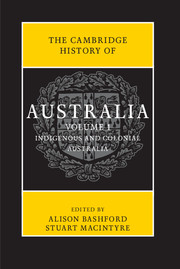Book contents
- Frontmatter
- Contents
- Abbreviations
- List of maps
- List of figures
- List of tables
- Notes on contributors
- Map
- Preface
- Introduction
- PART I
- 1 The past 50,000 years: an archaeological view
- 2 Newcomers, c. 1600–1800
- 3 Convict transportation in global context, c. 1700–88
- 4 The early colonial presence, 1788–1822
- 5 Expansion, 1820–50
- 6 The advent of self-government, 1840s–90
- 7 The gold rushes of the 1850s
- 8 Colonial states and civil society, 1860–90
- 9 Rethinking the 1890s
- 10 Making the federal Commonwealth, 1890–1901
- PART II
- Further reading
- Chronology
- Index
- Frontmatter
- Contents
- Abbreviations
- List of maps
- List of figures
- List of tables
- Notes on contributors
- Map
- Preface
- Introduction
- PART I
- PART II
- Further reading
- Chronology
- Index
10 - Making the federal Commonwealth, 1890–1901
from PART I
Published online by Cambridge University Press: 05 November 2013
- Frontmatter
- Contents
- Abbreviations
- List of maps
- List of figures
- List of tables
- Notes on contributors
- Map
- Preface
- Introduction
- PART I
- 1 The past 50,000 years: an archaeological view
- 2 Newcomers, c. 1600–1800
- 3 Convict transportation in global context, c. 1700–88
- 4 The early colonial presence, 1788–1822
- 5 Expansion, 1820–50
- 6 The advent of self-government, 1840s–90
- 7 The gold rushes of the 1850s
- 8 Colonial states and civil society, 1860–90
- 9 Rethinking the 1890s
- 10 Making the federal Commonwealth, 1890–1901
- PART II
- Further reading
- Chronology
- Index
- Frontmatter
- Contents
- Abbreviations
- List of maps
- List of figures
- List of tables
- Notes on contributors
- Map
- Preface
- Introduction
- PART I
- PART II
- Further reading
- Chronology
- Index
Summary
On 8 January 1901 an anonymous Australian ‘special correspondent’ for the London Morning Post recorded the momentous events that had taken place in Sydney one week earlier. As midnight struck, hymns, choruses and a ‘tumultuous uproar’ sounded in the streets; whistles, bells, gongs and the clanging of kitchen utensils joined the hooting and shrieking of people, boats and steam pipes. Later that morning, a great procession moved through the city streets, passing under a sequence of ornamental arches and making its way to the vast Centennial Park south-east of the city, created in 1888 for the centenary of Britain's colonisation of New South Wales. There, the Federation of Australia's six colonies was completed, and the Commonwealth of Australia inaugurated. Under a white pavilion, the Lord's Prayer was recited and Queen Victoria's Proclamation of the Commonwealth read out. The first Australian governor-general, John Adrian Louis Hope, Seventh Earl of Hopetoun and representative of Victoria, Queen of the United Kingdom and Ireland, was sworn in by the Chief Justice of New South Wales. The first prime minister, Edmund Barton, and his handful of executive ministers were then sworn in by Hopetoun. As the ceremony concluded, a massed choir broke into the Hallelujah Chorus and children sang Australian and British patriotic songs, while a vast crowd of spectators, seated on the grassy slopes around the pavilion, applauded.
Among the men who took the oath of office was none other than the Morning Post correspondent, Alfred Deakin, the new attorney-general, spiritualist, writer, barrister, former colonial politician and undisputed leader of Victoria's federalist movement, who would secretly comment on Australia's progress for the following thirteen years, even while he occupied (three times) the office of prime minister. On the day of the inauguration, he wrote, ‘a very self-conscious nation…[had] just made its appearance in the centre of the Southern Seas’.
- Type
- Chapter
- Information
- The Cambridge History of Australia , pp. 242 - 266Publisher: Cambridge University PressPrint publication year: 2013
- 2
- Cited by



